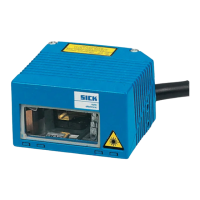
Do you have a question about the SICK CLV 410 and is the answer not in the manual?
| Model | CLV 410 |
|---|---|
| Scanning Technology | Laser |
| Light Source | Laser Diode |
| Wavelength | 650 nm |
| Resolution | 0.1 mm |
| Power Consumption | 2.5 W |
| Interface | RS-232 |
| Supply Voltage | 10 V DC ... 30 V DC |
| Operating Temperature | 0°C to +50°C |
| Storage Temperature | -20°C to +60°C |
| Scan Rate | 500 scans/s |
| Code Types | 1D barcodes |
Covers FCC compliance, personnel safety, and CDRH laser labels for safe operation.
Introduces the manual and highlights the scanner's capabilities and ease of use.
Explains the scanning principle and the laser source characteristics.
Discusses factors for choosing a scanner and types of label presentation.
Details line/raster scanners, programming methods, and parameter storage.
Covers unpacking, laser safety, and indicator LED functions for initial setup.
Explains how the scanner can be oriented for end or side scanning applications.
Guides on mounting the CLV scanner and achieving proper alignment for optimal reading.
Provides a detailed description of the CLV's interface ports and pin assignments.
Details power requirements and basic scanner connection configurations.
Explains how to connect multiple scanners in a master/slave or pass-through chain.
Details setting up the CLV scanner as part of an RS 485 multidrop network.
Guides on transferring scanner settings and explains primary operating modes.
Allows programming the scanner to accept specific bar code types and quantities.
Configures code positioning, minimum distances, and the quantity of codes to read.
Detailed configurations for Code 39, Interleaved 2/5, EAN, UPC, Codabar, Code 128, Code 93, EAN 128, Pharmacode.
Sets minimum bar width, minimum distance, and scanning frequency for optimal reading.
Reading distance and scan frequency for CLV 410 Close Range and CLV 412 High Density models.
Configures device settings, segmentation, and quiet zone adjustments.
Configures the source and behavior of the clock pulse that initiates scanning.
Sets up discrete outputs and beeper behavior for read results and other events.
Configures bar code comparison and filters output based on match criteria.
Covers learning bar codes for matching and assigning unique device IDs.
Configures scanner roles and host communication parameters like baud rate.
Defines data structure, headers, separators, terminators, and error strings.
Masks or rearranges specific characters within the scanned bar code data for output.
Configures host communication protocols, wrong read formats, and error reporting.
Sets up network communication and determines when data is sent to the host.
Configures code sorting, length settings, and percent evaluation for alignment.
Displays internal scanner statistics and identification details like model and serial number.
Covers initial power-up, self-test, and verifying scanner operation.
Details optical alignment procedures and explains the function of scanner indicator LEDs.
Explains operational messages, read quality, and how to interpret output data.
Details the types of diagnostic data available and their output locations within the data string.
Describes controlling the scanner using command strings sent via the host interface.
Covers basic maintenance like cleaning optical surfaces and the system self-test procedure.
Introduces error messages and provides contact info for technical support.
Addresses issues when the device is not ready or experiencing clock pulse problems.
Solves data transfer failures and ST=3 status output issues.
Diagnoses why the Result LED is off and problems with bar code presentation or quality.
Troubleshoots incorrect output settings and failures in AutoSetup mode.
Addresses problems with AutoSetup wait times and profile programming failures.
Lists key technical specifications including scanning capabilities and electrical requirements.
Presents different mounting bracket options for installing the CLV scanner.
Provides a summary of default settings for various bar code types and scanner configurations.
Lists ASCII character codes, their hexadecimal values, and corresponding control codes.
Provides conversion factors for length, area, volume, velocity, and flow.